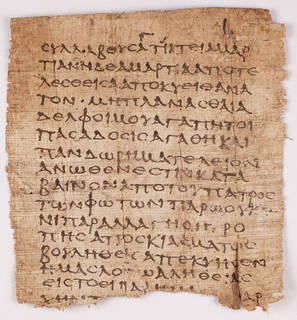
Preservation Self-Assessment Program
Papyrus
Although papyrus falls outside the scope of the PSAP, here are a few key aspects of the material that should help to distinguish it from paper.

-
Description
-
Papyrus is a paper-like material that was used over several thousand years, seeing its greatest popularity from 4th century B.C. to 4th century A.D as a writing support in Egypt, Greece, and Rome. Papyrus production involves cutting or peeling the papyrus reed plant into long strips. Strips were then soaked, rolled, and placed into overlapping layers, then pressed and left to dry to form sheets or rolls. Starch paste may have been used to strengthen the cross-lamination of the layers. Superior grades of papyrus come from the center of the plant, which appears brown in color. Papyrus formed from strips of the outer edges of the plant will generally appear more yellowish-white.
Many American and European museums and private collectors began to acquire papyrus artifacts during the 19th and 20th centuries. In this period, many curators stored papyrus between glass sheets or mounted it with acidic paper, films, and adhesives. Unfortunately, these housing and mounting techniques prove detrimental over time to papyrus, causing staining, embrittlement, and irreversible changes to the artifact.
-
Preservation
- Regardless of quality, papyrus will lose flexibility over time due to its own acidic nature. Although proper storage, handling, and treatment should help to prolong its life, most ancient papyri will naturally be desiccated, discolored, and brittle due to its cellulose/lignin composition. Papyrus is a fragile material, and it can fracture or fray easily when under stress. It is also prone to curling and is sensitive to high heat and humidity.
-
Identification
- Papyrus can be easily identified by its characteristic grid pattern. Brittle and lifting surface fibers may also help to identify papyrus. The easiest way to identify papyrus is to examine a sheet by viewing light through it, holding it up to a light, or using a light table. The cross-laminated layers should then become apparent.
Resources
- Cornell University Library - Preservation and Conservation. 2005. Papyrus. Retrieved from: https://www.library.cornell.edu/preservation/librarypreservation/mee/preservation/papyrus.htm
- Owen, A., Danzing, R. (1993). The history and treatment of the papyrus collection at the Brooklyn Museum. The Book and Paper Group, Annual, 12. Retrieved from: http://cool.conservation-us.org/coolaic/sg/bpg/annual/v12/bp12-10.html
- Stanley, T. (1994). Papyrus storage at Princeton University. The Book and Paper Group Annual, 13. Retrieved from: http://cool.conservation-us.org/coolaic/sg/bpg/annual/v13/bp13-10.html